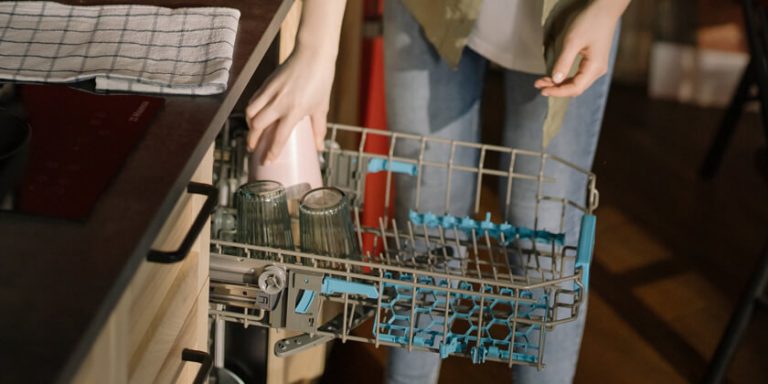Why wait for your dishwasher to completely break down before you replace it? If it’s time for a replacement, do not delay!
In many cases, a dishwasher will give many warning signs that its end is near: strange noises, unusual water spots on the dishes and water leaking on the floor are some.
If your dishwasher is showing these symptoms or is over eight years old, it’s time for a replacement. Hiring a professional is the first step for most homeowners, but for those who are on a budget, Googling “how to replace a dishwasher?” might be their first step, as they consider venturing down the DIY route.
If you’re part of the latter group, worry not. Replacing a dishwasher might seem like a job saved only for professionals, but when you know the basics of dishwasher removal and installation, you’ll save more money from the DIY project.
How to Safely Remove a Dishwasher
The first step in any dishwasher replacement project is removal. This involves disconnecting power and water connections, as well as dealing with the hardware that holds the dishwasher in place. Enlisting help from a family member or a friend will make this work, especially since removing a dishwasher requires extracting the appliance from the countertop.

To disconnect your dishwasher, you’ll need:
- Screwdrivers
- Channel-lock pliers
Instructions:
- Shut off the power. Find the electric cord that powers up the dishwasher and unplug it from the outlet.
In case your appliance is hard-wired into an electrical circuit, turn off the circuit breaker controlling the dishwasher’s circuit wires, which are inside the connection panel (located behind the access panel). Unless you are experienced with electrical work, it’s best to have a professional do this part of the job. - Turn off the water. Find the shutoff valve that controls the dishwasher’s water line. Usually, this is located under the sink. If your dishwasher does not have a fixture shutoff valve, turn off your house’s primary water valve before turning off the water.
- Disconnect the water supply. Before you remove the appliance, disconnect the pipes that connect the dishwasher to the plumbing system. If the dishwasher has a shut-off valve, it has a clear source of connection. Use channel-lock pliers to disconnect the dishwasher supply tube from the shut-off valve’s outlet. There are two types of outlets: a single outlet or a double outlet valve. It depends if the valve controls the hot water of both the faucet and dishwasher.
- Disconnect the drain line. Look for the rubber hose coming from the dishwasher and loosen the clamp or clip holding the hose to the air gap and detach the hose.
- Remove the mounting brackets. A couple of metal mounting brackets usually hold the dishwasher in place. Open the door and look under the kitchen counter’s lip for the brackets. Remove the screws and lower the dishwasher.
- Remove the appliance. Once you’ve unfastened the appliance, slide it out of the cabinet. Lift it slightly to clear the edge of the floor covering. Have another person slide under the sink to drain the hose and feed the water supply tube.
To avoid scratches on the floor, lift the dishwasher slightly as you pull it out of the cabinet. Protect the floor with newspapers or a drop cloth.
How to Safely Replace a Dishwasher
Once you’ve removed your old appliance, prep the new dishwasher. Most new appliances come with a layer of insulation wrapped around the unit for protection. Don’t remove it since the wrap serves as a sound barrier.

Instead, carefully tip the appliance back and remove the panel at the bottom of your dishwasher. Next, connect the elbow joints to drain the lines and fill the valve. Wrap the joints’ threads in Teflon tape to create a water-tight seal.
After preparing your appliance, here are the tools you’ll need to install a new dishwasher:
- Adjustable wrench
- 4-in-1 screwdriver
- Pliers
- Level
- Voltage tester
- Teflon tape
- Braided stainless steel water line (optional)
Instructions:
-
- Read the instruction manual. Your installation manual will tell you everything you need to know about your dishwasher, especially the requirements for a proper set-up. If you have never installed a dishwasher on your own, read the entire manual, then read it again a few more times. Never disregard the manual! Make sure you understand all of the processes and have the materials you need before you start installing your appliance.
- Attach the electric cord. Most of the appliance’s working parts — both the plumbing connections and electrical hookups — sit behind the access panel, which is located on the front bottom part of the appliance.
Instead of making these connections while you lie or crouch on the floor, lay the dishwasher on its back to remove the access panel and make the connections.
Remove the cover on the wire connection housing. Next, thread the power cord into the appliance then make three wire connections: black hot wire to black dishwasher lead, white neutral wire to white dishwasher lead and green wire from the appliance cord to the green grounding screw. - Connect the water supply. Most dishwasher connector kits include a dishwasher 90 that connects the water supply to your dishwasher. Install this to hook up your new appliance to the water supply.
Look for the water inlet fitting and apply some joint compound to the dishwasher 90 fitting’s threads. Tighten it by hand before you tighten it again with an adjustable wrench or channel-lock pliers.Also, thread the coupling nut of the supply tube onto the fitting and tighten it again. Avoid over-tightening the threads to prevent stripping.

- Position the dishwasher. Turn the appliance right side up and slide it under the kitchen counter (or wherever your dishwasher is positioned). This will feed the water supply tube, the power cord and the drain hose in the cabinet’s sidewall. Position the appliance to the center of the opening without pushing it too far.
Raise and level the appliance by using its adjustable legs according to the instruction manual. If you want to bring the dishwasher up to counter height, unscrew its legs with pliers. - Fasten the dishwasher. Once you’re satisfied with the dishwasher’s placement, anchor it in place. Open the appliance’s door to access the mounting brackets and use the screws to secure it in place.
- Connect everything that has to be connected. First, connect the water supply tube to the shut-off valve, which can be found under the kitchen sink. Turn on the shut-off valve and check for leaks. If there are leaks, tighten the fittings.
Next, connect the drain hose. In most cases, the rubber drain hose is already attached to the dishwasher. If not, you can use a hose clamp to do so. - Test the dishwasher. Once everything is in place, plug the dishwasher’s electric cord. Before attaching the face-plate to the appliance, test it by running the dishwasher through a full cycle. Check if the drain water is flowing properly.
Dishwasher Replacement FAQs
To cap off this “How-to” guide, here are some commonly asked questions associated with removing and replacing a dishwasher:
-
- Is replacing a dishwasher difficult? The difficulty level of DIY dishwasher replacement is intermediate. The project doesn’t require advanced electrical or plumbing skills. Proper know-how and knowledge of the equipment are enough.
- How long does it take to replace a dishwasher? The project can take an hour or two to complete, depending on your skills.
-
- Can I replace a dishwasher myself? In most cases, you don’t need special skills to tools to install or remove a dishwasher.
-
- What can you do with an old dishwasher? Selling is one of the first things you can do. You can also donate it or recycle it for a more eco-friendly option. Some recycling centers offer money in exchange for old appliances.
Should your dishwasher need replacing and you don’t have the budget to hire a professional, you can do the project yourself. As long as you arm yourself with the basics in dishwasher removal and installation, you can easily replace any dishwasher model easily.











